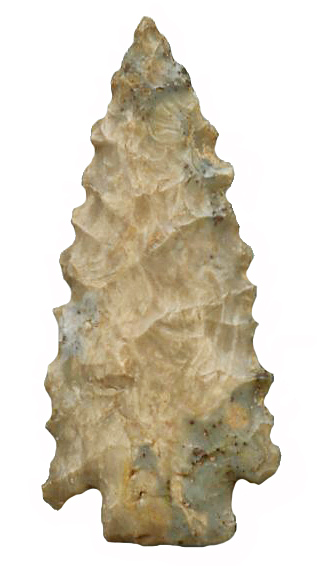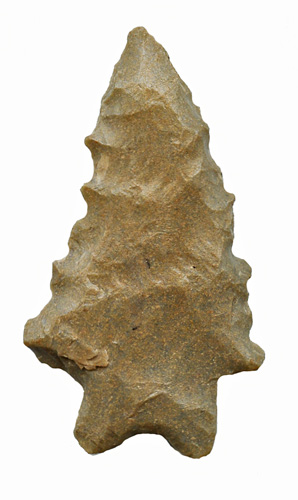



Point Type:
KIRK STEMMED
Also See: Elora, Flint Creek, Hamilton,
Heavy Duty, St. Tammany, Stanly
Location: Eastern Central, Eastern Seaboard, Southeastern
States
Associated Dates: 9000 - 6000 B.P. -
Early Archaic
Morphology:
Stemmed
General Description: The Kirk Stemmed point type is
a medium to large sized, barbed, stemmed point with deep notches or fine serrations along the blade edges. The
stem is parallel to expanding. The
stem sides may be steeply beveled on opposite faces. Some examples also
have a distinct bevel on the right hand side of each blade edge. The base
can be concave, convex or straight, and can
be very short. The shoulders
are usually strongly barbed. It is believed
that the Kirk Stemmed type may have evolved into the Stanly and other
types.
The Kirk Stemmed is found form the Mississippi River to the
East Coast and from New England to Florida. A variety of the Kirk Stemmed is found
in the southwestern Arkansas, Louisiana and southeastern Oklahoma area.
The dimensions of the
Kirk Stemmed are as follows. The length can range from 70mm to 150mm with the
average being 100mm. The width can range from 30mm to 50mm with the average
width being 35mm. The thickness ranges from 8mm to 15mm with the average
being 10mm in thickness.
The Kirk Stemmed
Point was named by Joffre L. Coe in 1964 for points found at the Hardaway site
in North Carolina.
Coe initially thought that the point type
was two separate types: The Kirk Stemmed and the Kirk Serrated.
These two types, are for the most part, only differentiated by the amount of
reworking on the blade edges (serrations). Coe suggested that the original outline of the
point was a long dagger-like blade profile with deep serrations and a
broad stem. The point is also known as the "heavy duty serrated" in
Ohio.
About The Point Above (Left): The Kirk Stemmed and serrated point pictured at the top left hand side of this page, was a surface find in Meade County, Kentucky and is very small for the type. It is made from a very appealing tan and gray mottled hornstone or Kentucky chert material that has a slight gloss. The barb on the right has a minor ding which reduces its overall width. The blade surface has some very nice mostly parallel to slightly oblique transverse flaking. Both blade edges have been reworked and are serrated but not deeply beveled. The base is very lightly ground. The specimen measures 45 mm in length, 22 mm wide across the barbs, and is only 5.8 mm at its thickest point at mid blade. The base tapers down to 4 mm in thickness. The stem length is only 6 mm and is problematic for this particular specimen as it relates to the type. Catalog Number 181-29-C
About The Point Above (Right): The Kirk Stemmed and serrated point pictured at the top right hand side of this page, was a surface find from western Tennessee and is very small for the type. It is made from a tan and gray colored chert material that has a satin lustre. Both blade edges have been reworked and are serrated but not deeply beveled. The left hand blade edge is convex due to a former reworked impact fracture. The base is very lightly ground and is convex. The specimen measures 48 mm in length, 27.4 mm wide across the barbs, and is only 6.8 mm at its thickest point at mid blade. The base tapers down to 4.1 mm in thickness. The stem length is 10 mm and the stem width is 16.1 mm. The right hand side of each blade edge is beveled. This specimen was formerly in the Will Burkett collection and prior to that was in the Rocky Hall collection. Catalog Number 420-15-HH
References: Coe, DeRegnaucourt, Dragoo, Hranicky (1), Henschel, Justice (1), Overstreet, Perino (1)
© Copyright 1997 - 2009 LITHICS-Net WWW.LITHICSNET.COM
Use your Browser's BACK Button to return to the LITHICS-Net Index.